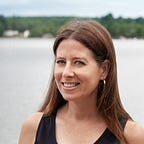I Read A Lot of Inappropriate Books As a Child
And I Hope My Children Do the Same
I was fortunate to grow up in a house with a lot of books and within walking distance from an excellent public library. (Shout out Queens Public Library!) As a result, from a young age I was able to really experiment, to pick up books that had interesting titles or covers and see what they were all about. In this way, I read many, many inappropriate books.
While my parents didn’t actively prohibit me, they didn’t necessarily endorse my reading of “mature” books. For example, I read Judy Blume’s Tales of a Fourth Grade Nothing when I was in first grade. In one scene, a character makes an off-handed comment about the non-existence of Santa. (Obviously, I was embarrassingly old to believe in Santa, but let’s put that aside for minute). In shock and dismay, I asked my mother to reassure me that it wasn’t true, that Santa was, in fact, real. Instead, annoyed, she said, “That’s what you get for reading a book above your grade level.”
I didn’t learn the lesson that I think she wanted me to learn, however. Instead, I more assiduously hid books that I imagined would be met with disapproval. In third grade, I read another Judy Blume gem, Forever, which was being passed around our classroom because of its frank discussions of periods and sex. The book’s cover featured a round locket that contained the picture of a wistful-looking young woman and a subtitle: “A moving story of the end of innocence.” I was reading it on the couch, I thought inconspicuously, when my mother caught a glimpse. She narrowed her eyes and asked, suspiciously, “What’s that book about?”
“Horses,” I lied, nervously.
She frowned, but she left me alone.
I’m sure she knew better; how could she not? Ultimately, I’m grateful for the permissiveness that my parents afforded me — at least when it came to books.
In middle school, I continued to read illicit books, thrillers and mysteries that contained fascinating and incomprehensible scenes, often about sex. Once, when I was about fourteen, I accompanied my elderly aunt and her friends to the beach. We settled in our chairs and I hauled out a serious-looking hard cover that I’d just gotten from the library. When they asked me what I was reading, I held it out to them: Erica Jong’s The Fear of Flying. They gasped. I wasn’t sure what the big deal was. I’d heard it was a feminist classic. I thought they were being precious.
I gasped too, however, a few moments later, when I discovered that I’d picked up a large-print edition of some famous erotica. The first chapter is titled, in part, “The Zipless Fuck.”
I put The Fear of Flying back in my beach bag pretty quickly, but I sure took it out again later, when I was alone.
Reading books that dealt with issues that I didn’t understand, that were “too mature,” that would have been off-limits if my parents had been aware of them: this, I think was one of the delights of my life as a young reader. It allowed me to have secrets and to do something mildly rebellious that was also, in retrospect, sort of fortifying and positive. I grappled with ideas and information that challenged me, I puzzled over vocabulary that stymied me (even with a dictionary handy) and I was exposed to adult conversations and arguments that intrigued me. Frankly, I did not understand or remember much of what I read. But reading these books keyed me into the fact that there was more out there than the complicated social and romantic hierarchies and dramas of my adolescent world, that there were other kinds of families, neighborhoods, and people. During times when I felt naïve or awkward or just generally ridiculous, reading “mature” books allowed me to feel worldly and sophisticated and, well, mature. It was important not only for my developing sense of self, but for my understanding of the world around me and my place in it.
Perhaps this goes without saying, but I think it’s very different to encounter challenging content in a book than it is online — especially when it comes to sex. Images and videos online often leave little to the imagination, while, as a young reader, I often had to think hard and perform all sorts of mental gymnastics to figure out what was going on in a passage (and I suspect my conclusions were often inaccurate). And while books can certainly be shocking and upsetting, even as an adult, I find books are also a bit easier to put down and walk away from, to get distance from before deciding whether or not to return to them.
Now that I’m a parent, I don’t censor what my children read. They are not the readers that I once was or that I sometimes wish they were, but you should see how my older son, in particular, will tear through a graphic novel if he has an inkling that it may contain a curse word or a scene that I would “tsk-tsk” over. And so I make sure to give my kids free reign at the library, as well keep our own shelves stocked with books that might someday entice them — including those classics Forever and Go Ask Alice and Tales of a Fourth Grade Nothing, as well as more “literary” fare that I read before I knew what I was reading, like Alice Walker’s The Color Purple and Truman Capote’s In Cold Blood, as well recent publications geared at older kids, like Raina Telgemeier’s graphic novels, Jarrett Krosoczka’s Hey, Kiddo and M-E Girard’s Girl Mans Up. I think, though, that I’ll keep Fear of Flying on a higher shelf for now.
